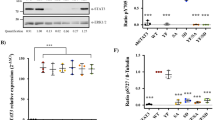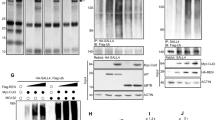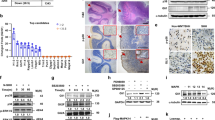Abstract
Wilms' tumor (WT), one of the most common pediatric solid cancers, arises in the developing kidney as a result of genetic and epigenetic changes that lead to the abnormal proliferation and differentiation of the metanephric blastema. As activation of signal transducers and activators of transcription (STATs) plays an important role in the maintenance/growth and differentiation of the metanephric blastema, and constitutively activated STATs facilitate neoplastic behaviors of a variety of cancers, we hypothesized that dysregulation of STAT signaling may also contribute to WT pathogenesis. Accordingly, we evaluated STAT phosphorylation patterns in tumors and found that STAT1 was constitutively phosphorylated on serine 727 (S727) in 19 of 21 primary WT samples and two WT cell lines. An inactivating mutation of S727 to alanine reduced colony formation of WT cells in soft agar by more than 80% and induced apoptosis under conditions of growth stress. S727-phosphorylated STAT1 provided apoptotic resistance for WT cells via upregulation of expression of the heat-shock protein (HSP)27 and antiapoptotic protein myeloid cell leukemia (MCL)-1. The kinase responsible for STAT1 S727 phosphorylation in WT cells was identified based upon the use of selective inhibitors as protein kinase CK2, not p38, MAP-kinase kinase (MEK)1/2, phosphatidylinositol 3′-kinase, protein kinase C or Ca/calmodulin-dependent protein kinase II (CaMKII). The inhibition of CK2 blocked the anchorage-independent growth of WT cells and induced apoptosis under conditions of growth stress. Our findings suggest that serine-phosphorylated STAT1, as a downstream target of protein kinase CK2, plays a critical role in the pathogenesis of WT and possibly other neoplasms with similar STAT1 phosphorylation patterns.
This is a preview of subscription content, access via your institution
Access options
Subscribe to this journal
Receive 50 print issues and online access
$259.00 per year
only $5.18 per issue
Buy this article
- Purchase on Springer Link
- Instant access to full article PDF
Prices may be subject to local taxes which are calculated during checkout








Similar content being viewed by others
References
Abril E, Real LM, Serrano A, Jimenez P, Garcia A, Canton J et al. (1998). Cancer Immunol Immunother 47: 113–120.
Barasch J, Yang J, Ware CB, Taga T, Yoshida K, Erdjument-Bromage H et al. (1999). Cell 99: 377–386.
Benekli M, Baer MR, Baumann H, Wetzler M . (2003). Blood 101: 2940–2954.
Bianchi L, Tacchini L, Cairo G . (1999). Nucleic Acids Res 27: 4223–4227.
Bowman T, Garcia R, Turkson J, Jove R . (2000). Oncogene 19: 2474–2488.
Bromberg J . (2002). J Clin Invest 109: 1139–1142.
Bromberg J, Chen X . (2001). Methods Enzymol 333: 138–151.
Cox AD, Der CJ . (2002). Cancer Biol Ther 1: 599–606.
Danial NN, Rothman P . (2000). Oncogene 19: 2523–2531.
Decker T, Kovarik P . (2000). Oncogene 19: 2628–2637.
Dome JS, Coppes MJ . (2002). Curr Opin Pediatr 14: 5–11.
Ford HL, Landesman-Bollag E, Dacwag CS, Stukenberg PT, Pardee AB, Seldin DC . (2000). J Biol Chem 275: 22245–22254.
Frank DA, Mahajan S, Ritz J . (1997). J Clin Invest 100: 3140–3148.
Friedberg JW, Dong DA, Li S, Kim H, Stephans K, Noonan K et al. (2004). Leukemia Res 28: 139–147.
Garrido C, Schmitt E, Cande C, Vahsen N, Parcellier A, Kroemer G . (2003). Cell Cycle 2: 579–584.
Gessler M, Konig A, Arden K, Grundy P, Orkin S, Sallan S et al. (1994). Hum Mutat 3: 212–222.
Heller-Harrison RA, Czech MP . (1991). J Biol Chem 266: 14435–14439.
Huang S, Bucana CD, Van Arsdall M, Fidler IJ . (2002). Oncogene 21: 2504–2512.
Hudelist G, Czerwenka K, Singer C, Pischinger K, Kubista E, Manavi M . (2005). Cancer Genet Cytogenet 158: 35–42.
Ihle JN . (2001). Curr Opin Cell Biol 13: 211–217.
Kabakov AE, Budagova KR, Bryantsev AL, Latchman DS . (2003). Cell Stress Chaperones 8: 335–347.
Kaplan DH, Shankaran V, Dighe AS, Stockert E, Aguet M, Old LJ et al. (1998). Proc Natl Acad Sci USA 95: 7556–7561.
Khodarev NN, Beckett M, Labay E, Darga T, Roizman B, Weichselbaum RR . (2004). Proc Natl Acad Sci USA 101: 1714–1719.
Koesters R, Ridder R, Kopp-Schneider A, Betts D, Adams V, Niggli F et al. (1999). Cancer Res 59: 3880–3882.
Koopman G, Reutelingsperger CP, Kuijten GA, Keehnen RM, Pals ST, van Oers MH . (1994). Blood 84: 1415–1420.
Koshikawa N, Maejima C, Miyazaki K, Nakagawara A, Takenaga K . (2006). Oncogene 25: 917–928.
Kovarik P, Mangold M, Ramsauer K, Heidari H, Steinborn R, Zotter A et al. (2001). EMBO J 20: 91–100.
Kovarik P, Stoiber D, Eyers PA, Menghini R, Neininger A, Gaestel M et al. (1999). Proc Natl Acad Sci USA 96: 13956–13961.
Kumar A, Commane M, Flickinger TW, Horvath CM, Stark GR . (1997). Science 278: 1630–1632.
Levy DE, Gilliland DG . (2000). Oncogene 19: 2505–2510.
Lin W, Kemper A, McCarthy KD, Pytel P, Wang JP, Campbell IL et al. (2004). J Neurosci 24: 10074–10083.
Madamanchi NR, Li S, Patterson C, Runge MS . (2001). Arterioscler Thromb Vasc Biol 21: 321–326.
Maiti S, Alam R, Amos CI, Huff V . (2000). Cancer Res 60: 6288–6292.
Michels J, Johnson PW, Packham G . (2005). Int J Biochem Cell Biol 37: 267–271.
Nair JS, DaFonseca CJ, Tjernberg A, Sun W, Darnell Jr JE, Chait BT et al. (2002). Proc Natl Acad Sci USA 99: 5971–5976.
Nishiu M, Yanagawa R, Nakatsuka S, Yao M, Tsunoda T, Nakamura Y et al. (2002). Jpn J Cancer Res 93: 894–901.
Ouchi T, Lee SW, Ouchi M, Aaronson SA, Horvath CM . (2000). Proc Natl Acad Sci USA 97: 5208–5213.
Packham G, Stevenson FK . (2005). Immunology 114: 441–449.
Pansky A, Hildebrand P, Fasler-Kan E, Baselgia L, Ketterer S, Beglinger C et al. (2000). Int J Cancer 85: 720–725.
Parcellier A, Gurbuxani S, Schmitt E, Solary E, Garrido C . (2003). Biochem Biophys Res Commun 304: 505–512.
Plisov SY, Yoshino K, Dove LF, Higinbotham KG, Rubin JS, Perantoni AO . (2001). Development 128: 1045–1057.
Qing Y, Stark GR . (2004). J Biol Chem 279: 41679–41685.
Rigolet M, Faussillon M, Baudry D, Junien C, Jeanpierre C . (2001). Pediatr Nephrol 16: 1113–1121.
Roberts D, Schick J, Conway S, Biade S, Laub PB, Stevenson JP et al. (2005). Br J Cancer 92: 1149–1158.
Ruteshouser EC, Huff V . (2004). Am J Med Genet C 129: 29–34.
Santelli G, Califano D, Chiappetta G, Vento MT, Bartoli PC, Zullo F et al. (1999). Am J Pathol 155: 799–804.
Sarno S, Moro S, Meggio F, Zagotto G, Dal Ben D, Ghisellini P et al. (2002). Pharmacol Ther 93: 159–168.
Sarno S, Reddy H, Meggio F, Ruzzene M, Davies SP, Donella-Deana A et al. (2001). FEBS Lett 496: 44–48.
Sarto C, Valsecchi C, Magni F, Tremolada L, Arizzi C, Cordani N et al. (2004). Proteomics 4: 2252–2260.
Seldin DC, Landesman-Bollag E, Farago M, Currier N, Lou D, Dominguez I . (2005). Mol Cell Biochem 274: 63–67.
Shen Y, Devgan G, Darnell Jr JE, Bromberg JF . (2001). Proc Natl Acad Sci USA 98: 1543–1548.
Spiekermann K, Biethahn S, Wilde S, Hiddemann W, Alves F . (2001). Eur J Haematol 67: 63–71.
Stalter G, Siemer S, Becht E, Ziegler M, Remberger K, Issinger OG . (1994). Biochem Biophys Res Commun 202: 141–147.
Stephanou A, Brar BK, Scarabelli TM, Jonassen AK, Yellon DM, Marber MS et al. (2000). J Biol Chem 275: 10002–10008.
Stephanou A, Isenberg DA, Nakajima K, Latchman DS . (1999). J Biol Chem 274: 1723–1728.
Stephanou A, Latchman DS . (2003). Int J Exp Pathol 84: 239–244.
Stephanou A, Scarabelli TM, Brar BK, Nakanishi Y, Matsumura M, Knight RA et al. (2001). J Biol Chem 276: 28340–28347.
Sun WH, Pabon C, Alsayed Y, Huang PP, Jandeska S, Uddin S et al. (1998). Blood 91: 570–576.
Terui K, Haga S, Enosawa S, Ohnuma N, Ozaki M . (2004). Biochem J 380: 203–209.
Unger GM, Davis AT, Slaton JW, Ahmed K . (2004). Curr Cancer Drug Targets 4: 77–84.
Vanden Heuvel GB, Bodmer R, McConnell KR, Nagami GT, Igarashi P . (1996). Kidney Int 50: 453–461.
Varinou L, Ramsauer K, Karaghiosoff M, Kolbe T, Pfeffer K, Muller M et al. (2003). Immunity 19: 793–802.
Wang D, Moriggl R, Stravopodis D, Carpino N, Marine JC, Teglund S et al. (2000). EMBO J 19: 392–399.
Wang G, Unger G, Ahmad KA, Slaton JW, Ahmed K . (2005). Mol Cell Biochem 274: 77–84.
Widschwendter A, Tonko-Geymayer S, Welte T, Daxenbichler G, Marth C, Doppler W . (2002). Clin Cancer Res 8: 3065–3074.
Xu W, Nair JS, Malhotra A, Zhang JJ . (2005). J Interferon Cytokine Res 25: 113–124.
Yu J, McMahon AP, Valerius MT . (2004). Curr Opin Genet Dev 14: 550–557.
Zhang JJ, Zhao Y, Chait BT, Lathem WW, Ritzi M, Knippers R et al. (1998). EMBO J 17: 6963–6971.
Zien P, Duncan JS, Skierski J, Bretner M, Litchfield DW, Shugar D . (2005). Biochim Biophys Acta 1754: 271–280.
Zykova TA, Zhang Y, Zhu F, Bode AM, Dong Z . (2005). Carcinogenesis 26: 331–342.
Acknowledgements
We thank Dr Nadya Tarasova for critical review of the manuscript, Dr Elizabeth Perlman for providing the tissue slides, and Kathleen Noer and Roberta Matthai from CCR Flow Cytometry Core and Barbara Kasprzak from Pathology Histotechnology Laboratory for excellent assistance. The research was supported by the Intramural Research Program of the NIH, National Cancer Institute, Center for Cancer Research.
Author information
Authors and Affiliations
Corresponding author
Additional information
Supplementary Information accompanies the paper on the Oncogene website (http://www.nature.com/onc).
Supplementary information
Rights and permissions
About this article
Cite this article
Timofeeva, O., Plisov, S., Evseev, A. et al. Serine-phosphorylated STAT1 is a prosurvival factor in Wilms' tumor pathogenesis. Oncogene 25, 7555–7564 (2006). https://doi.org/10.1038/sj.onc.1209742
Received:
Revised:
Accepted:
Published:
Issue Date:
DOI: https://doi.org/10.1038/sj.onc.1209742
Keywords
This article is cited by
-
The combination of ruxolitinib and Bcl-2/Mcl-1 inhibitors has a synergistic effect on leukemic cells carrying a SPAG9::JAK2 fusion
Cancer Gene Therapy (2022)
-
Nuclear ADP-ribosylation drives IFNγ-dependent STAT1α enhancer formation in macrophages
Nature Communications (2021)
-
Selenium-binding protein 1 transcriptionally activates p21 expression via p53-independent mechanism and its frequent reduction associates with poor prognosis in bladder cancer
Journal of Translational Medicine (2020)
-
Cancer-induced inflammation and inflammation-induced cancer in colon: a role for S1P lyase
Oncogene (2019)
-
The homeoprotein DLX4 controls inducible nitric oxide synthase-mediated angiogenesis in ovarian cancer
Molecular Cancer (2015)



